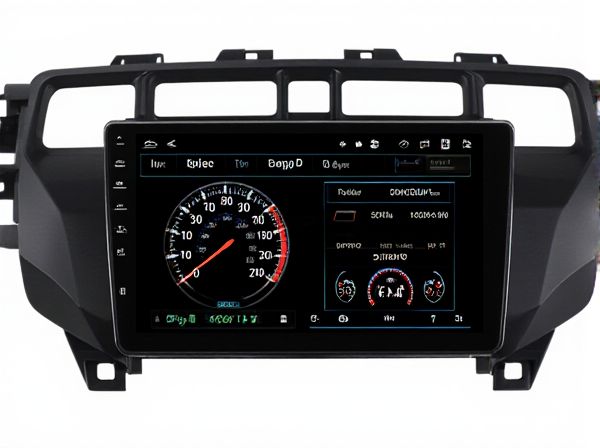
Photo illustration: LCD Display Cluster vs TFT Display Cluster
LCD display clusters offer clear visuals with lower power consumption, making them ideal for basic instrumentation in vehicles. TFT display clusters provide sharper image quality and faster response times, enhancing the user interface with vibrant colors and improved readability in various lighting conditions. Your choice depends on whether you prioritize energy efficiency or advanced graphical performance in your dashboard display.
Table of Comparison
| Feature | LCD Display Cluster | TFT Display Cluster |
|---|---|---|
| Display Technology | Liquid Crystal Display (LCD) | Thin Film Transistor (TFT) LCD |
| Image Quality | Basic clarity, lower contrast | High resolution, vivid colors, sharp contrast |
| Brightness | Moderate brightness | Higher brightness, better visibility in sunlight |
| Response Time | Slower response, possible ghosting | Faster response, smoother animations |
| Viewing Angles | Narrow viewing angles | Wide viewing angles, consistent display |
| Power Consumption | Lower power usage | Higher power consumption due to enhanced features |
| Cost | More affordable | Typically more expensive |
| Common Usage | Basic dashboards in economy cars | Advanced dashboards in premium and sporty vehicles |
Introduction to Automotive Display Clusters
Automotive display clusters serve as the primary interface between drivers and vehicle information systems, with LCD and TFT technologies representing key advancements in this field. LCD display clusters typically use liquid crystal technology to present clear, static images with energy efficiency, while TFT display clusters employ thin-film transistor technology for improved color accuracy, higher resolution, and faster refresh rates. These display types significantly enhance driver experience by providing real-time data, navigation, and customizable interfaces tailored to modern automotive needs.
Understanding LCD Display Clusters
LCD display clusters utilize liquid crystal technology to present clear, energy-efficient visuals with superior brightness and contrast compared to traditional analog gauges. These clusters often feature monochrome or basic color displays capable of showing critical vehicle data such as speed, fuel levels, and engine warnings with minimal power consumption. Understanding LCD clusters is essential for recognizing their advantages in automotive design, including durability, cost-effectiveness, and ease of integration within varied dashboard configurations.
Overview of TFT Display Clusters
TFT display clusters utilize thin-film transistor technology to deliver high-resolution, vibrant color images with superior brightness and contrast compared to traditional LCD display clusters. These clusters offer faster refresh rates and improved viewing angles, enhancing the readability of vehicle instrument panels in various lighting conditions. Advanced integration with vehicle systems allows TFT clusters to display dynamic information, such as navigation and real-time diagnostics, providing a more interactive and customizable user experience.
Key Differences Between LCD and TFT Clusters
LCD display clusters utilize liquid crystal technology to present basic monochrome or simple color visuals, offering lower resolution and limited viewing angles. TFT display clusters are an advanced type of LCD that incorporate thin-film transistor technology, providing higher resolution, vibrant colors, faster response times, and wider viewing angles. The key differences lie in image quality, color accuracy, and display performance, with TFT clusters delivering superior clarity and responsiveness compared to standard LCD clusters.
Display Quality and Resolution Comparison
LCD display clusters typically offer good color accuracy and brightness but may suffer from limited viewing angles and lower contrast ratios compared to TFT display clusters. TFT display clusters utilize thin-film transistor technology to deliver higher resolution, sharper images, and enhanced color vibrancy, resulting in superior display quality overall. The improved pixel control in TFT displays ensures better response times and reduced motion blur, making them ideal for modern automotive instrument clusters.
Performance and Response Time Analysis
TFT display clusters typically offer faster response times and higher refresh rates compared to LCD display clusters, making them more suitable for dynamic content and real-time data visualization in automotive applications. Performance-wise, TFT displays provide superior color accuracy, contrast ratios, and brightness levels, enhancing visibility under various lighting conditions. While LCD clusters rely on liquid crystal technology that can introduce latency in pixel response, TFT clusters utilize active matrix technology for quicker transitions, resulting in smoother user interface experiences.
Durability and Environmental Resistance
TFT display clusters offer enhanced durability compared to traditional LCD display clusters due to their improved resistance to impact and vibrations, making them ideal for rugged automotive environments. TFT clusters typically feature better environmental resistance against extreme temperatures, moisture, and UV exposure, extending their operational lifespan in harsh conditions. In contrast, standard LCD clusters may suffer from reduced performance and longevity when exposed to prolonged environmental stressors.
User Experience and Interface Capabilities
LCD display clusters offer clear visibility and energy efficiency suited for basic user interfaces, while TFT display clusters provide enhanced color accuracy, higher resolution, and faster response times, significantly improving graphic-rich interfaces and real-time feedback. TFT clusters support multi-touch capabilities and dynamic content rendering, enabling a more interactive and intuitive user experience compared to standard LCDs. The choice between LCD and TFT clusters impacts user engagement by balancing clarity, responsiveness, and interface versatility.
Cost Implications and Market Trends
LCD display clusters typically offer a cost-effective solution for automotive manufacturers due to their simpler technology and lower production expenses, making them more accessible for budget-conscious models. TFT display clusters, leveraging thin-film transistor technology, provide superior image quality and color vibrancy but involve higher manufacturing costs, influencing their adoption primarily in premium vehicles. Market trends reveal a growing shift toward TFT clusters as consumer demand for advanced, customizable digital interfaces increases, despite the higher price point compared to traditional LCD counterparts.
Choosing the Right Display Cluster for Your Vehicle
Choosing the right display cluster for your vehicle depends on factors like visibility, durability, and cost. LCD display clusters offer better energy efficiency and sharper text visibility in bright sunlight, making them ideal for fuel-efficient and eco-friendly models. TFT display clusters deliver richer colors and higher contrast, enhancing the driving experience through vivid graphics and real-time information, suitable for premium and performance vehicles.
 caratoz.com
caratoz.com